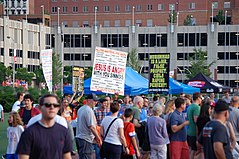
American Muslims often face Islamophobia and racialization due to stereotypes and generalizations ascribed to them. Due to this, Islamophobia is both a product of and a contributor to the United States' racial ideology, which is founded on socially constructed categories of profiled features, or how people seem.[1][2][3]
Advocacy groups like the Center for American Progress explain that this social phenomenon is not new; rather, it has increased its presence in American social and political discourse over the last ten to fifteen years. They cite the fact that several organizations donate large amounts of money to create the "Islamophobia megaphone".[4] CAP defines the megaphone analogy as "a tight network of anti-Muslim, anti-Islam foundations, misinformation experts, validators, grass root organizations, religious rights groups and their allies in the media and in politics" who work together to misrepresent Islam and Muslims in the United States.[4] As a result of this network, Islam is now one of the most stigmatized religions, with only 42 percent of Americans having a favorable opinion of Islam, according to a 2021 Associated Press/Norc Center for Public Affairs Research poll.[5] Similarly, Muslims are one of the most negatively viewed religious groups in the United States, with atheists being the only other group seen in a comparable negative light.[6] This biased perception of Islam and Muslims manifests itself into the discrimination of racially perceived Muslims in the law and media, and is conceptually reinforced by the Islamophobia network.
A report by the University of California Berkeley and the Council on American–Islamic Relations estimated that $206 million was funded to 33 groups whose primary purpose was "to promote prejudice against, or hatred of, Islam and Muslims" in the United States between 2008 and 2013, with a total of 74 groups contributing to Islamophobia in the United States during that period.[7] This has been referred to as the "Islamophobia industry" by scholars Nathan Lean and John Esposito.[8]
- ^ Aziz, Sahar F. (2021). The Racial Muslim: When Racism Quashes Religious Freedom. University of California Press. ISBN 978-0-520-38228-2.
- ^ Selod, Saher (2018). Forever Suspect: Racialized Surveillance of Muslim Americans in the War on Terror. Rutgers University Press. ISBN 978-0-8135-8834-6.
- ^ Love, Erik (2017). Islamophobia and Racism in America. NYU Press. ISBN 978-1-4798-3807-3.
- ^ a b Wajahat, Ali; Clifton, Eli; Duss, Matthew; Fang, Lee; Keyes, Scott; Shakir, Faiz (August 2011). Fear, Inc. The Roots of the Islamophobia Network in America. Washington D.C.: Center for American Progress.
- ^ "Two decades after 9/11, Muslim Americans still fighting bias". The Associated Press. September 7, 2021. Retrieved November 26, 2021.
- ^ Mohamed, Besheer (September 1, 2021). "Muslims are a growing presence in U.S., but still face negative views from the public". Pew Research Center. Retrieved March 23, 2022.
- ^ "Funding fear of Muslims: $206m went to promoting 'hatred', report finds". The Guardian. June 20, 2016.
- ^ Lean, Nathan (2012). The Islamophobia Industry: How the Right Manufactures Fear of Muslims (PDF). Pluto Press. p. 66. JSTOR j.ctt183p6tt.7.
© MMXXIII Rich X Search. We shall prevail. All rights reserved. Rich X Search
